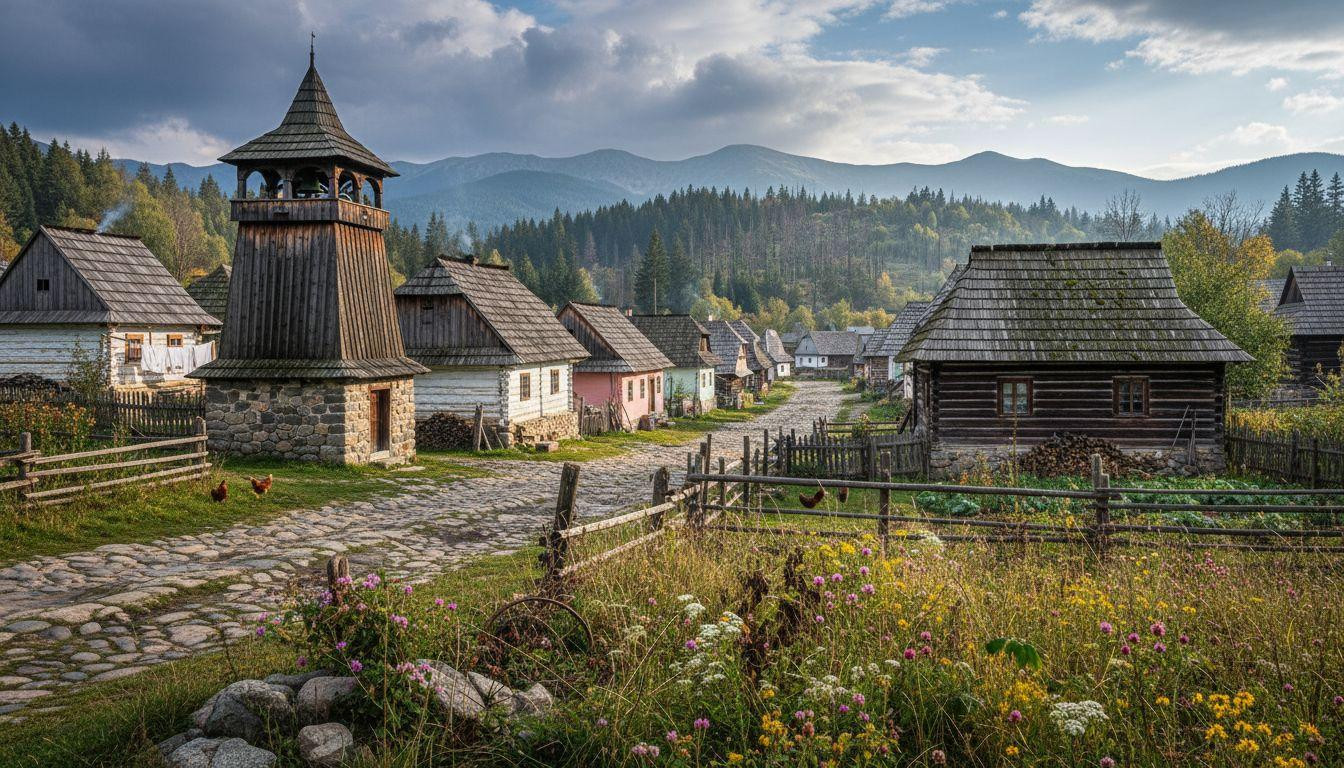Tour buses clog the narrow streets of Holašovice, Czech Republic, where wooden farmhouses now house souvenir shops instead of families. This UNESCO village became a victim of its own beauty, transforming from a living community into an outdoor museum. Just 150 miles southeast, Slovakia’s Vlkolínec offers everything Holašovice promised before fame destroyed its soul.
Vlkolínec sits quietly in the Veľká Fatra foothills, where 19 residents still call 45 wooden houses home. Morning smoke rises from chimneys as chickens wander cobblestone streets. No tour bus parking lots scar the landscape.
Why Holašovice lost its authentic village charm
Holašovice attracts over 200,000 visitors annually, overwhelming its 140 residents. Prague day-trip operators flood the village with buses carrying tourists who spend 90 minutes photographing baroque farmsteads before departing. The once-thriving community now functions as an open-air museum where gift shops occupy buildings that housed farming families for centuries.
South Bohemian accommodation averages $111 per night, with limited options forcing visitors into standardized pensions. Properties like Pension Špejchar u Vojty charge $240 nightly for four-person apartments. The flat farmland setting lacks the dramatic mountain backdrop that defines authentic Carpathian villages.
Local tourism boards acknowledge the challenge. Overtourism transformed Holašovice from a working agricultural community into a preserved showcase where authentic village life exists only in interpretive displays.
Meet Vlkolínec: Central Europe’s last living wooden village
Slovakia’s tourism statistics reveal the country’s hidden potential. In 2025, Slovakia welcomed 2.16 million visitors, yet Vlkolínec receives fewer than 70,000 annually. This UNESCO World Heritage site preserves 650 years of continuous habitation without surrendering its residential character.
Carpathian architecture frozen since 1376
Forty-five wooden houses rise on stone foundations, their horizontal log walls painted in soft pastels. White, pink, yellow, and green facades create a living rainbow against the mountain backdrop. An 18th-century wooden bell tower from 1770 dominates the skyline, its weathered shingles catching morning light.
The village follows a traditional two-line street pattern with long courtyards. Houses feature clay-plastered walls over timber frames, wooden shingle roofs, and hand-carved details passed down through generations. Unlike Holašovice’s restored museum pieces, these structures serve their original purpose.
The numbers that prove authenticity
Nineteen permanent residents maintain village life year-round. Accommodation costs $35-55 nightly in nearby Ružomberok, 40% less than South Bohemian rates. Traditional meals featuring bryndzové halušky cost $8-12 compared to $15-20 in tourist-heavy Holašovice.
Village entry remains free, contrasting sharply with commercial heritage sites charging entrance fees. Exhibition houses require modest fees of $3-5, while the UNESCO House and Granary offer free displays.
What you’ll experience in authentic Vlkolínec
November mornings bring mist rising from valleys as wood smoke drifts between houses. Residents tend gardens, feed livestock, and maintain homes their families have occupied for generations. The absence of tour groups creates space for genuine encounters with village life.
A village that still breathes
Local artisans sell hand-carved wooden items and traditional textiles from their homes. The village pub serves Slovak specialties to residents and visitors alike. Sheep graze in courtyards while cats sunbathe on stone foundations, creating scenes unchanged for centuries.
Museum house #16-17 demonstrates traditional interior life without theatrical presentations. Craft demonstration areas showcase living skills rather than performed heritage. Medieval preservation here serves daily life, not tourist entertainment.
Beyond village boundaries
Hiking trails lead into Veľká Fatra National Park from village edges. Sidorovo Mountain rises to 3,609 feet, offering wilderness access impossible from flat Holašovice. Ružomberok provides restaurants serving traditional Liptov cuisine at authentic prices.
Winter transforms wooden houses into fairytale scenes without commercialized Christmas markets. Folk music festivals occur naturally rather than as scheduled tourist events. Village experiences unfold organically throughout seasons.
Planning your escape from overtourism
Slovakia’s tourism recovery shows 5.4% growth in 2025’s first seven months. Foreign visitor numbers increased 2% while domestic tourism declined, creating opportunities for international travelers seeking authenticity. November offers particularly peaceful village exploration.
Train service connects Bratislava to Ružomberok in 4.5 hours for $30-40. Local buses run every two hours between Ružomberok station and Vlkolínec for $1-2. Walking the 2-mile route takes 30 minutes through countryside absent of tour bus traffic.
Your Questions About Vlkolínec Answered
How do costs compare with Czech alternatives?
Vlkolínec region accommodation costs 40% less than South Bohemian properties. Meals average $8-12 versus $15-20 in Holašovice. Transportation from capital cities costs similar amounts, but daily expenses favor Slovakia significantly.
What makes this village authentically lived-in?
Nineteen permanent residents conduct normal village life. Smoke rises from chimneys, laundry hangs in courtyards, and locals tend gardens. Children play in streets where their grandparents grew up. This contrasts sharply with Holašovice’s museum atmosphere.
Why choose Slovakia over established Czech destinations?
Slovakia offers genuine cultural immersion without performative heritage displays. UNESCO designation recognizes Vlkolínec as the best-preserved Carpathian settlement. Visitor numbers remain manageable while architectural integrity exceeds Czech counterparts.
Golden afternoon light catches the bell tower’s wooden shingles as mountain mist descends. A resident tends her garden while cats stretch on warm stone foundations. This scene represents what Holašovice offered before UNESCO fame rewrote its story into tourist performance.
